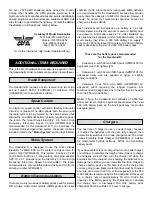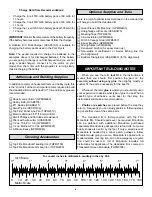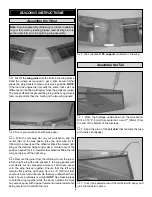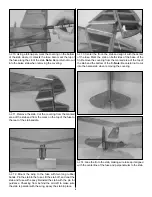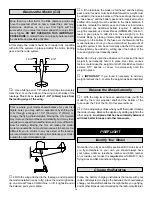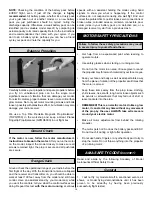
Before you get ready to takeoff, see how the model handles
on the ground by doing a few practice runs at low speeds on
the runway. If you need to calm your nerves before the maiden
flight, shut the motor down and bring the model back into the
pits. Top off the battery with a quick peak charge, then check
all fasteners and control linkages for peace of mind.
For your first few flights, it is a good idea to hand launch the
model to retain as much power as possible for flight.
ALWAYS have an experienced modeler who knows how to
propel a model straight ahead complete the first tosses.
If you decide to do rolling take offs, then remember to takeoff
into the wind. When you’re ready, point the model straight
down the runway, then gradually advance the throttle. Gain
as much speed as your runway and flying site will practically
allow before gently applying up elevator, lifting the model into
the air. At this moment it is likely that you will need to apply
more right rudder to counteract motor torque. Be smooth on
the elevator stick, allowing the model to establish a gentle
climb to a safe altitude before turning into the traffic pattern.
For reassurance and to keep an eye on other traffic, it is a
good idea to have an assistant on the flight line with you. Tell
him to remind you to throttle back once the plane gets to a
comfortable altitude. While full throttle is usually desirable for
takeoff, most models fly more smoothly at reduced speeds.
Take it easy with the Headwind B for the first few flights,
gradually getting acquainted with it as you gain confidence.
Adjust the trims to maintain straight and level flight. After
flying around for a while, and while still at a safe altitude with
plenty of battery power still left, practice slow flight and
execute practice landing approaches by reducing the throttle
to see how the model handles at slower speeds. Add power
to see how she climbs as well. Continue to fly around,
executing various maneuvers and making mental notes (or
having your assistant write them down) of what trim or C.G.
changes may be required to fine tune the model so it flies
the way you like. Mind your power response, but use this first
flight to become familiar with your model before landing.
To initiate a landing approach, lower the throttle while on the
downwind leg. Allow the nose of the model to pitch downward
to gradually bleed off altitude. Continue to lose altitude, but
maintain airspeed by keeping the nose down as you turn onto
the crosswind leg. Make your final turn toward the runway (into
the wind) keeping the nose down to maintain airspeed and
control. Level the attitude when the model reaches the runway
threshold, modulating the throttle as necessary to maintain
your glide path and airspeed. If you are going to overshoot,
smoothly advance the throttle (always ready on the right
rudder to counteract torque) and climb out to make another
attempt. When you’re ready to make your landing flare and the
model is a foot or so off the deck, smoothly increase up
elevator until it gently touches down. Once the model is on the
runway and has lost flying speed, hold up elevator to place the
tail on the ground, regaining tail wheel control.
One final note about flying your model. Have a goal or flight
plan in mind for every flight. This can be learning a new
maneuver(s), improving a maneuver(s) you already know, or
learning how the model behaves in certain conditions (such as
on high or low rates). This is not necessarily to improve your
skills (
though it is never a bad idea!), but more importantly so
you do not surprise yourself by impulsively attempting a
maneuver and suddenly finding that you’ve run out of time,
altitude or airspeed. Every maneuver should be deliberate, not
impulsive. For example, if you’re going to do a loop, check your
altitude, mind the wind direction (anticipating rudder
corrections that will be required to maintain heading),
remember to throttle back at the top, and make certain you are
on the desired rates (high/low rates). A flight plan greatly
reduces the chances of crashing your model just because of
poor planning and impulsive moves. Remember to think.
Have a ball! But always stay in control
and fly in a safe manner.
GOOD LUCK AND GREAT FLYING!
Landing
Flight
Takeoff
CAUTION (THIS APPLIES TO ALL R/C AIRPLANES): If,
while flying, you notice any unusual sounds, such as a
low-pitched “buzz,” this may indicate control surface
flutter. Because flutter can quickly destroy components of
your airplane, any time you detect flutter you must
immediately cut the throttle and land the airplane! Check
all servo grommets for deterioration (this may indicate
which surface fluttered), and make sure all pushrod
linkages are secure and free of play. If the control surface
fluttered once, it probably will flutter again under similar
circumstances unless you can eliminate the free-play or
flexing in the linkages. Here are some things which can
cause flutter: Excessive hinge gap; Not mounting control
horns solidly; Poor fit of clevis pin in horn; Side-play of
pushrod in guide tube caused by tight bends; Poor fit of Z-
bend in servo arm; Insufficient glue used when gluing in
the elevator joiner wire; Excessive
play or backlash in
servo gears; and Insecure servo mounting.
15



